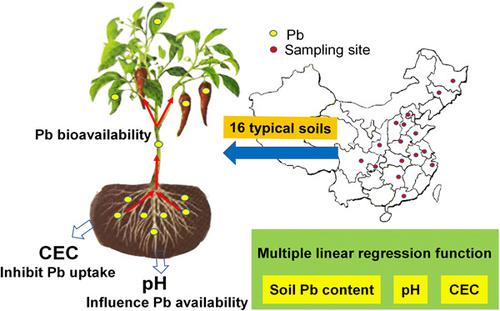当前位置:
X-MOL 学术
›
Environ. Toxicol. Chem.
›
论文详情
Our official English website, www.x-mol.net, welcomes your
feedback! (Note: you will need to create a separate account there.)
Controlling Factors and Prediction of Lead Uptake and Accumulation in Various Soil–Pepper Systems
Environmental Toxicology and Chemistry ( IF 3.6 ) Pub Date : 2021-01-27 , DOI: 10.1002/etc.4997 Jingxuan Shi 1, 2 , Qiao Xu 1, 2 , Zhen Zhou 1, 2 , Xiaoshuai Wu 1, 2 , Jianhao Tong 1, 2 , Qiongyao Cai 1, 3 , Qianhua Wu 1, 2 , Jiyan Shi 1, 2
Environmental Toxicology and Chemistry ( IF 3.6 ) Pub Date : 2021-01-27 , DOI: 10.1002/etc.4997 Jingxuan Shi 1, 2 , Qiao Xu 1, 2 , Zhen Zhou 1, 2 , Xiaoshuai Wu 1, 2 , Jianhao Tong 1, 2 , Qiongyao Cai 1, 3 , Qianhua Wu 1, 2 , Jiyan Shi 1, 2
Affiliation

|
Lead (Pb) is a typical toxic heavy metal element in soils and plants, which has a potential threat to human health through the food chain. Uptake of Pb in the soil–vegetable system has attracted broad attention, whereas reports on the main controlling factors of Pb uptake and accumulation in different soil–vegetable systems are limited. The effect of soil properties on Pb uptake and accumulation in pepper (Capsicum annuum L.) was studied by a pot experiment with 16 typical soils in China. The results showed that the Pb bioavailability was lower in alkaline soils, and that soil cation exchange capacity (CEC), CaCO3, and total phosphorus contents might influence the uptake and transfer of Pb by peppers. Soil pH and CEC were the most significant factors affecting Pb accumulation in pepper fruits. Soil pH was negatively correlated with Pb uptake and accumulation due to its influence on Pb mobility and bioavailability. The accumulation of Pb decreased as soil CEC increased, which might inhibit the absorption and transfer of Pb in peppers. The multiple linear regression function based on soil Pb content, pH, and CEC could provide enough information for a good prediction of the accumulation of Pb in soil–pepper systems (R2 = 0.733). The results are in favor of developing a Pb threshold for vegetables in agricultural soils in China, thus improving the food safety of crops. Environ Toxicol Chem 2021;40:1443–1451. © 2021 SETAC
更新日期:2021-01-27











































 京公网安备 11010802027423号
京公网安备 11010802027423号